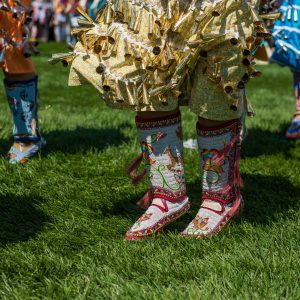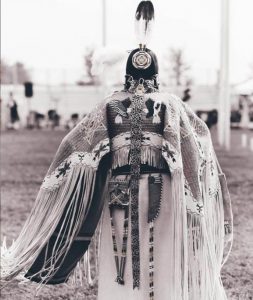 Jingle Dress
Jingle Dress
The Jingle Dress dance style evolved in the early 1920s with the Anishinaabe (Ojibwe) as a ceremonial dance, and the style is as symphonic as the regalia. The regalia is distinctive and admirable; shiny metal cones are sewn into many rows on the skirt and sometimes even the blouse. They swing and rattle to create a rain-like sound. Dancers carry fans or bags and often wear eagle plumes on their heads. There are two types of Jingle Dress dance styles, traditional and modern. In traditional Jingle Dress movements, the footwork is kept light, nimble, and close to the ground. Modern dance steps have become more elaborate, and the footwork more complex. Dancers are judged by their footwork, grace, and pose.
 Traditional
Traditional
Women’s Traditional dance style is considered to be the most elegant form of dance, with its origin dating back to the First World War. This type of dance exemplifies grace, modesty, and dignity. The regalia is made with buckskin or cloth. Dancers usually wear a breastplate, a shawl, and a fan that is often made with eagle feathers. A belt is often worn, with an attached knife sheath, awl carrier, or strike light bag. There are two types of dance styles, Northern and Southern. Northern dancers often dance in place with the fringe of their dress and shawl swaying to the beat. Southern dancers, on the other hand, move gracefully around the dance circle with their fringe swaying back and forth.
 Fancy Shawl
Fancy Shawl
Fancy Shawl is a relatively new addition to the dance styles and is considered to be the most athletic and fast paced. This style of dance emerged in the early 20th century in the Northern Plains area. The regalia is colorful, and dancers typically wear calf-length dresses or skirts with bright shawls and beadwork. The dancers move around the circle quickly to the beat of the music while spinning and using fancy footwork. They are judged by their innovation, rhythm, and repetition.
